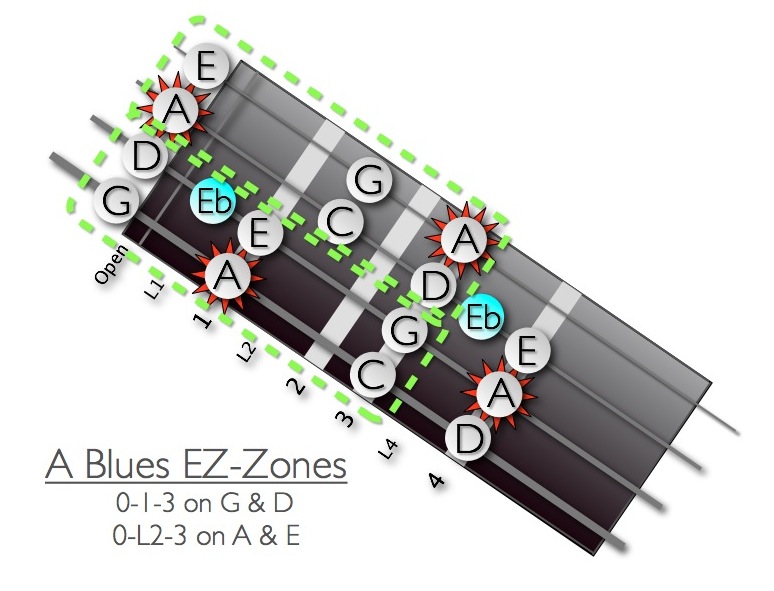Short answer:
“EZ-Zones” are super easy two-string finger patterns that help you to jam right away with more authority and joy, even if you are a near-beginner!
More…
The term “EZ-Zone” first appeared in my book/CD “Fiddle Jam, a way-cool EZ way to learn how to improvise!” (Hal Leonard Corp. 2002).
EZ-Zones are the cornerstone of the improvisational component of the Fiddle Jam Method. They are simply symmetrical fingerings on two adjacent strings on your standardly tuned violin, viola, cello, or mandolin. In plain English, they are “boxed” fingering sets on two strings right next to each other.
EZ-Zones only appear on the fingerboard in certain special keys and scales, and the Fiddle Jam Method’s Level 1 materials, found in the book and on the Fiddle Jam Institute website, focus, at first, only on these.
OK, next question: “What good are they?”
Many of the featured EZ-Zones are Blues scales. Blues scales have a hip, fun, and cool sound that makes it easy for students to want to express themselves creatively!
In my 35+ years of teaching, “EZ-Zones” are the best way I’ve found to boost an improv-new-bee into playing with some joy & authority in the shortest possible span of time and experience. Generally, they are technically simple enough so that a near-beginner can not only play them, but be creative with them very early in their development. I have even pushed these limits at some teaching conferences, to get people who’ve never even played a violin before, to jam the blues with me within a minute or two!
How do EZ-Zones work?
EZ-Zones work by being easy! Their simplicity makes them a near “no-brainer” to memorize and begin to not think too much about their execution, but allow and encourage the user to be able to focus on the more important aspects of music making: feel and fun! This approach helps the student develop an “inside-out” flow to music making, the result which is much more natural feeling and sounding than the traditional “outside-in” approach of reading from the page first.
What do you do with them?
Jam! The actual instructions are very simple: Just use the notes within the EZ-Zone box to play whatever you feel will sound good, by yourself, or to a supplied audio track that I’ve specially made to fit the EZ-Zone key. There are no right or wrong answers in improvisation… including playing notes that are NOT part of the EZ-Zone!
I suggest starting and ending on a “tonic” or name of the key/scale (notated by special starred fingering dots in the finger charts) and going back to these notes often. These tonic notes will sound more rested and finished… like putting a period or comma in your music sentence.
Further advice…
Don’t think too much! Just have fun. Musical fun most usually starts with creative rhythms. Even if you just have rhythmic fun on only one note (like the tonic). Over-thinking this stuff tends to dull down our creative mental processes. The more we think, the worse we sound in general…. at least as it pertains to improv. EZ-Zones are so simple, that it gives us more opportunity to not think so much, but rather “tap in” to your own creative ideas! This is where the true magic of music lies! Getting good and consistent with this mental technique may take some practice and time, but is the measure of greatness as a creator.
EZ-Zones can help you plant the seeds for development of this coveted non-thinking approach.
Long-term…
I’ve found that students who jam regularly even sound better and more authoritative on their learned pieces of music! If I have two students of about the same ability level, play the same piece in a recital, and one jams regularly and the other does not… the AUDIENCE can tell the difference! I hear comments like: “that one kids just has ‘it’.”
Why? The answer is simple. The jammers are practiced at hearing internally what they’d like to play FIRST and bringing it into reality… from the inside-out. This direction of flow will always sound and feel better. It is from the heart!
Keys used in the Fiddle Jam Method Level 1 materials:
Major: G, D & A
Blues: E, B, A, D, & G
Fiddle Jam EZ-Zone chart examples:
Ledger: Star = tonic or best starting/ending note. Green dotted box = EZ-Zone. “Blue” notes are optional extra notes found in blues scales. Tape marks and finger numbers = traditional violin fingering as taught by millions of teachers. Notes “outside” the EZ-Zone box are also allowed, but just not as easy to memorize or play.

 A Blues has TWO EZ-Zones! There is a whole chapter dedicated to this one in the original Fiddle Jam Book!
A Blues has TWO EZ-Zones! There is a whole chapter dedicated to this one in the original Fiddle Jam Book!
Check out more of our Fiddle Jam Book lessons to get some experience using these yourself!
<<::>>

No comments yet.